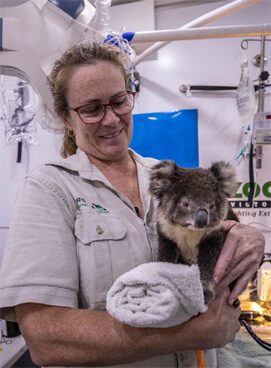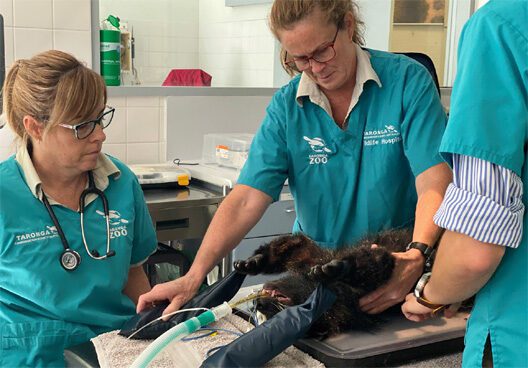No two days are the same for Taronga Zoo’s senior vet
Taronga Zoo’s senior veterinarian Kimberly Vinette Herrin says she was eccentric as a child.
“I was that sort of strange kid that would go out and collect caterpillars and watch them turn into moths or butterflies,” recalls Kimberly, who grew up in New York, USA. “I was always out in the wild collecting weird things.”
She even persuaded her father to let her hatch her own eggs – she had requested platypus eggs but had to make do with chicken eggs. “My parents tolerated me very well. My three younger siblings were all fairly normal,” she laughs.
Her grandparents lived in The Bronx, and whenever Kimberly visited them, they’d go to The Bronx Zoo. She recalls being around two or three years old and being impacted by the animals. “I just remember seeing the animals in these small 1960s or 1970s little cages behind bars and I remember thinking, ‘I’m going to help you someday,’” Kimberly says.
After completing a bachelor’s degree in biology, and a masters in oceanography while she lived in Alaska studying the feeding ecology of bowhead whales, she studied to be a vet, intending to use medicine as a conservation tool.
She’d always wanted to live in Australia and even did a semester in Adelaide as part of her undergraduate degree. Kimberly finally made it here, joining Taronga in 2006, after working as a vet at Gladys Porter Zoo in the south of Texas and Ocean Park aquarium in Hong Kong.
She’s now an Australian citizen, lives near Balmoral Beach and has a daughter in her thirties.
She’s done a few stints overseas with some of the zoo’s conservation partners including subantarctic research projects assessing elephant seals and sea lions, and satellite tracking marine turtles rehabilitated through Taronga Wildlife Hospital. She’s also participated in conservation programs for chimpanzees in the Republic of Congo, orang-utans in Indonesia and is on the board of the Sumatran Sun Bear team.

Kimberly triaged Victorian wildlife during the Black Summer bush rires of 2019/20
Kimberly took on the role of senior veterinarian at Taronga two years ago. Each day is different to the next at the zoo. Kimberly says they have a meeting in the mornings and have ‘a bit of a schedule,’ but things can change fast when you’re responsible for more than 200 species of animals.
“The animals usually dictate (the schedule),” says Kimberly. “Today we had a few things scheduled and the next thing we’ve got three or four birds coming in requiring an anaesthetic, and I thought I was going to do a pretty minor surgery on a koala that turned out to be a different major problem.”

A binturong having treatment under general anaesthetic
There are highs and lows to the job – the highs of new life being born and the lows of losing an animal they’ve know for their entire life.
“It’s almost like having 4,000 or so pets,” Kimberly says. “You’re responsible for all these animals’ lives. For me the marine animals and the primates are the most interesting. When we have the loss of one of the older chimps or one of the older primates that’s really emotional for me.”
Taronga gets about 1,000 sick or injured animals brought in every year and Kimberly loves to help wildlife such as little penguins or echidnas and release them back to the wild.
“My absolute favourite is the satellite tracking of marine turtles that come into our hospital and get rehabilitated,” explains Kimberly. “They will often end up in estuarine areas like Port Stephens. We’re looking at habitat use and hopefully this information can help us recommend areas that should have higher protection.”
Kimberly says it’s not hard to love her job. “I feel very proud to be able to help conservation and make this a better place for animals,” she says. “I love the diversity of what I do, and I love that not one day is the same.”








